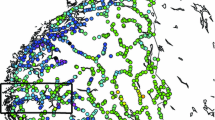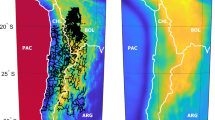Abstract
This paper addresses implementation issues in order to apply non-stationary least-squares collocation (LSC) to a practical geodetic problem: fitting a gravimetric quasigeoid to discrete geometric quasigeoid heights at a local scale. This yields a surface that is useful for direct GPS heighting. Non-stationary covariance functions and a non-stationary model of the mean were applied to residual gravimetric quasigeoid determination by planar LSC in the Perth region of Western Australia. The non-stationary model of the mean did not change the LSC results significantly. However, elliptical kernels in non-stationary covariance functions were used successfully to create an iterative optimisation loop to decrease the difference between the gravimetric quasigeoid and geometric quasigeoid at 99 GPS-levelling points to a user-prescribed tolerance.
Similar content being viewed by others
References
Andersen OB, Knudsen P, Berry PAM (2009) The DNSC08GRA global marine gravity field from double retracked satellite altimetry. J Geodesy. doi:10.1007/s00190-009-0355-9
Chilès JP, Delfiner P (1999) Geostatistics. Wiley, New York
Claessens SJ, Featherstone WE, Barthelmes F (2001) Experiences with point-mass modelling in the Perth region, Western Australia. Geomat Res Aust 75: 53–86
Cressie N (1993) Statistics for spatial data. Wiley, New York
Darbeheshti N, Featherstone WE (2009) Non-stationary covariance function modelling in 2D least-squares collocation. J Geodesy 83(6): 495–508. doi:10.1007/s00190-008-0267-0
Deutsch CV, Journel AG (1998) GSLIB. Oxford University Press, Oxford
Featherstone WE (1998) Do we need a gravimetric geoid or a model of the base of the Australian Height Datum to transform GPS heights?. Aust Survey 43(4): 273–280
Featherstone WE (2000) Refinement of gravimetric geoid using GPS and levelling data. J Survey Eng 126(2): 27–56. doi:10.1061/(ASCE)0733-9453
Featherstone WE (2004) Evidence of a north-south trend between AUSGeoid98 and the AHD in southwest Australia. Survey Rev 37(291): 334–343
Featherstone WE (2008) GNSS-heighting in Australia: current, emerging and future issues. J Spatial Sci 53(2): 115–133
Featherstone WE (2009) Only use ship-track gravity data with caution: a case-study around Australia. Aust J Earth Sci 56(2): 191–195. doi:10.1080/08120090802547025
Featherstone WE, Kirby JF, Kearsley AHW, Gilliland JR, Johnston GM, Steed J, Forsberg R, Sideris MG (2001) The AUSGeoid98 geoid model of Australia: data treatment, computations and comparisons with GPS-levelling data. J Geodesy 75(5-6): 313–330. doi:10.1007/s001900100177
Featherstone WE, Kuhn M (2006) Height systems and vertical datums: a review in the Australian context. J Spatial Sci 51(1): 21–42
Featherstone WE, Sproule DM (2006) Fitting AusGeoid98 to the Australian height datum using GPS-levelling and least squares collocation: application of a cross-validation technique. Survey Rev 38(301): 573–582
Forsberg R (1987) A new covariance model for inertial gravimetry and gradiometry. J Geophys Res 92(B2): 1305–1310
Forsberg R, Tscherning CC (2008) An overview manual for the GRAVSOFT. University of Copenhagen, Denmark
Higdon D, Swall J, Kern J (1999) Non-stationary spatial modelling. In: Bernardo JM, Berger JO, Dawid AP, Smith AFM (eds) Bayesian statistics, vol 6. Oxford University Press, Oxford, pp 761–768
Holmes SA, Pavlis NK (2006) Program HARMONIC_SYNTH a FORTRAN program for very-high-degree harmonic synthesis. National Geospatial-Intelligence Agency, USA
Kearsley AHW (1988) Tests on the recovery of precise geoid height differences from gravimetry. J Geophys Res 93(B6): 6559–6570
Kirby JF (2003) On the combination of gravity anomalies and gravity disturbances for geoid determination in Western Australia. J Geodesy 77(7–8): 433–439. doi:10.1007/s00190-003-0334-5
Kirby JF, Featherstone WE (2002) High-resolution grids of gravimetric terrain correction and complete Bouguer corrections over Australia. Explor Geophys 33(3-4): 161–165
Kuroishi Y, Ando H, Fukuda Y (2002) A new hybrid geoid model for Japan GSIGEO 2000. J Geodesy 76(8): 428–436. doi:10.1007/s00190-002-0266-5
Milbert DG, Dewhurst WT (1992) The Yellowstone-Hebgen lake geoid obtained through the integrated geodesy approach. J Geophys Res 97(B1): 545–557
Moritz H (1980) Advanced physical geodesy. Abacus, Tunbridge Wells
Pavlis NK, Holmes SA, Kenyon SC, Factor JK (2008) An earth gravitational model to degree 2160: EGM2008, EGU-2008, Vienna, April
Prutkin I, Klees R (2008) On the non-uniqueness of local quasi-geoids computed from terrestrial gravity anomalies. J Geodesy 82(3): 147–156. doi:10.1007/s00190-007-0161-1
Reguzzoni M, Sansò F, Venuti G (2005) The theory of general Kriging, with application to the determination of a local geoid. Geophys J Int 162(4): 303–314. doi:10.1111/j.1365-246X.2005.02662.x
Sideris MG (1990) Rigorous gravimetric terrain modeling using Molodensky’s operator. Manuscripta Geodaetica 15(2): 97–106
The Australian Height Datum (AHD) (1979) Rep 8, National Mapping Council of Australia, Canberra
Tziavos IN, Featherstone WE (2001) First results of using digital density data in gravimetric geoid computation in Australia. In: Sideris MG (eds) Gravity, Geoid and Geodynamics 2000. IAG Symposia Series, vol 123. Springer, pp 335–340
Wackernagel H (2003) Multivariate geostatistics: an introduction with applications. Springer, Berlin
Wessel P, Smith WHF (1998) New, improved version of Generic Mapping Tools released. EOS Trans AGU 79(47):579. http://gmt.soest.hawaii.edu/
You RJ (2006) Local geoid improvement using GPS and levelling data: case study. J Survey Eng 132(3): 101–107
Author information
Authors and Affiliations
Corresponding author
Rights and permissions
About this article
Cite this article
Darbeheshti, N., Featherstone, W.E. Tuning a gravimetric quasigeoid to GPS-levelling by non-stationary least-squares collocation. J Geod 84, 419–431 (2010). https://doi.org/10.1007/s00190-010-0377-3
Received:
Accepted:
Published:
Issue Date:
DOI: https://doi.org/10.1007/s00190-010-0377-3




